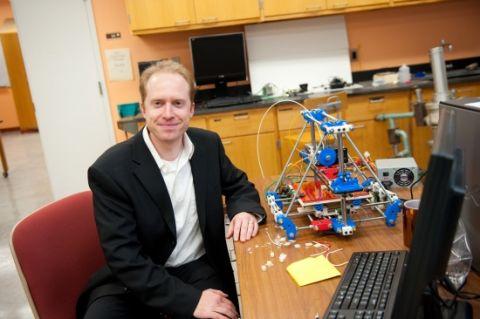In a previous post in this series, we looked at the opportunities related to open source assistive devices, often small and novel objects that can be 3D printed cheaply. Unique disabilities, circumstances, houses, bodies and jobs mean that 3D printing may be ideal for making these custom solutions.
In the first article, we considered the example of Western University Professor Joshua Pearce, whose team created an open source walker, which led me to identify six reasons why the project was inspiring.
Josh Pearce is an inventor surrounded by a community of inventors.
The resulting file and project are open source and free to use.
It is printable on a cheap printer and is inexpensive to make.
It marries 3D printing with mass-produced items.
It disrupts the inefficient industry of assistive devices
It empowers the end user.
I’d like to posit that these are the key criteria for a successful open source 3D printing solution for societal problems. Open source hardware innovation could be useful for many different issues that humanity faces. Let’s look more at the six success factors.
An Inventor Surrounded by a Community of Inventors
The 3D printing industry does not need anymore evangelists. There are already far too many, most of whom are completely useless, save for their self-promotional efforts. We need 3D printing implementers. We also don’t need inspirational leaders with sickly sweet rhetoric or world-changing Theranos ideas. We need an inventor who collects other inventors and tests, iterates, and pushes their team forward. Someone who is skilled and knowledgeable of the actual 3D printing and design element. Someone who wants to make real world things to solve real world problems. We already have a lot of open source and shared innovation going on, but this leader should channel a group effort toward a problem set.
Open Source and Free to Use.
This goes without saying, but open source innovation and hardware are key here. This means that anyone can contribute, while understanding the work done so far. It also means that there are no impediments to further improvement and sharing. This is the power of open source in this context.
Printable on a Cheap Printer, Inexpensive to Make
I really like powder bed fusion systems, but the idea here is that the millions of desktop 3D printer users worldwide can work on this problem and print out the results to test themselves. It also means that, in austere environments and low-income areas, the resulting parts will be accessible. A $100 solution, no matter how perfect, will just not work for the bottom four billion people. For solutions to really have an impact, they need to be spread wide and be truly inexpensive. With 3D printing, $2 parts could solve million-dollar issues. By finding these cases, the 3D printing industry can find true value. If these parts are then printed on $200 3D printers, they can be made and improved locally as well.
Marrying 3D Printing with Mass-produced Items
This one may not be a critical success factor. There could be plenty of 3D printed components that, in and of themselves, could be impactful. There are enough part-sized problems in the world. However, laser cutting, injection molding, pottery, and welding are all wonderful technologies. If one were to make a container that was meant to be cold, then pottery may actually make more sense. Why 3D print a pipe when it would be cheaper to buy one?
Disrupting Inefficient Industries
In markets, problems, and areas where little innovation is happening, open source hardware and 3D printing can have an outsized impact. By thinking about how to disrupt malaria or coal heating in homes, it’s possible to invent solutions that may be wholly new and breakthrough. By spotting the inefficiencies in a market, problem, place, or situation, we can find part-sized solutions to those problems.
Empowering the End User
However, we risk just pitching our values, ideas, and experiences to those with very different lives. We risk making fishing rods for those who cannot swim, don’t have boats, and don’t eat fish. This is better than just giving a person a fish, but still not optimal. By partnering with people, listening to them, showing empathy and understanding for their situation, we can make something that can help them to help themselves.
I believe that open source hardware can be applied to many different situations and problems. By combining it with desktop 3D printers, we can bring valuable parts that are cheap and quick to make to many across the globe.
Subscribe to Our Email Newsletter
Stay up-to-date on all the latest news from the 3D printing industry and receive information and offers from third party vendors.
You May Also Like
Further Understanding of 3D Printing Design at ADDITIV Design World
ADDITIV is back once again! This time, the virtual platform for additive manufacturing will be holding the first-ever edition of ADDITIV Design World on May 23rd from 9:00 AM –...
3D Printer Maker EVO-tech Reborn as NEVO3D — Once More With Feeling
EVO-tech was a 3D printing service and original equipment manufacturer established in 2013 and based in Schörfling am Attersee, Austria. The company produced high-quality material extrusion systems featuring linear bearings,...
3D Systems Brings 3D Printed PEEK Cranial Implant to the U.S. with FDA Clearance
For more than 10 years, 3D Systems (NYSE:DDD) has worked hand-in-hand with surgeons to plan over 150,000 patient-specific cases, and develop more than two million instruments and implants from its...
CDFAM Returns to Berlin for Second Annual Symposium
The second CDFAM Computational Design Symposium is scheduled for May 7-8, 2024, in Berlin, and will convene leading experts in computational design across all scales. Building upon the first event...

































